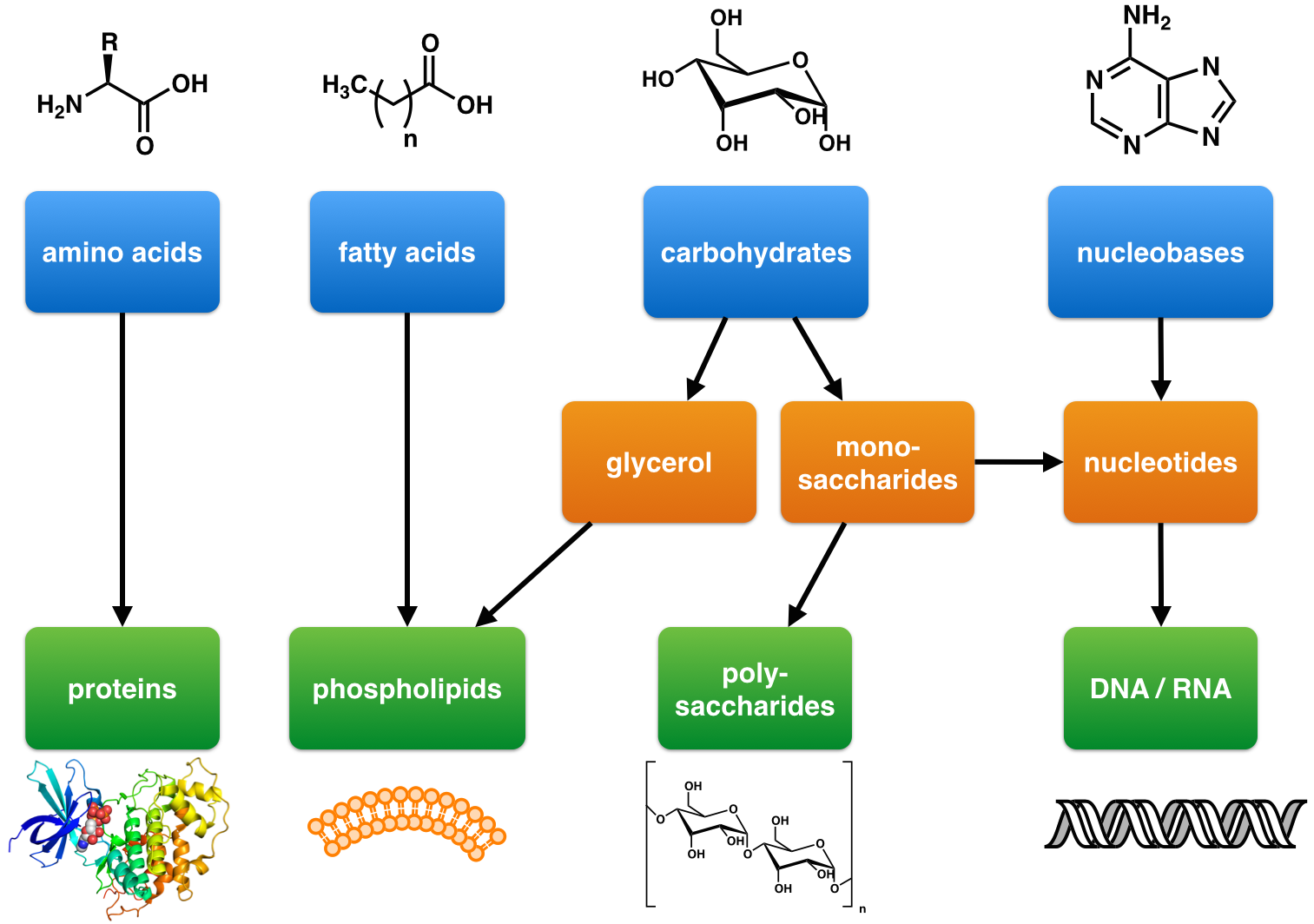Describe the Composition of Macromolecules Required by Living Organisms.
Organisms must exchange matter with the environment to grow reproduce and maintain organization ENE-1A Describe the composition of macromolecules required by living organisms. The highly complex organization of living systems requires constant input of energy and the exchange of macromolecules.

Types Of Biological Macromolecules Introduction To Chemistry
Atoms molecules from the environment are necessary to build new molecules- a.

. Three of the four classes of macromoleculescarbohydrates proteins and nucleic acidsform chainlike molecules called polymers. ENE-1A2 Atoms and molecules from the environment are necessary to build new molecules a. There is a wide range of macromolecules which include carbohydrates proteins lipids and nucleic acids.
However by adding different atoms and functional groups to a carbon chain it can take on a wide variety of other properties. Made of CH and O. Contain N in rings nucleotides made of sugar phosphate and nitrogenous base.
Describe the properties of the monomers and the type of bonds that connect the monomers in biological macromolecules. Contain N have N-C-C backbone. 13 Introduction of Biological Macromolecules SYI 1B Describe the.
Chemistry of Life Topic Learning Objectives 11 Structure of Water SYI 1A Explain how the properties of water that result from its polarity and hydrogen bonding affect its biological function. ESSENTIAL KNOWLEDGE ENE-1A1 Organisms must exchange matter with the environment to grow reproduce and maintain organization. Describe the composition of macromolecules required by living organisms.
Macromolecules required by living organisms. Macromolecule Notes shortDescribe the composition of macromolecules required by living organismsDescribe the properties of the monomers and the type of bonds that connect the monomers in biologi. In fact the basis for all biological macromolecules is long carbon chains with attached hydrogens.
Polysaccharides commonly known as carbohydrates are macromolecules. A type of carbohydrate. Describe the structural similarities.
13 Introduction to Biological Macromolecules. Explain how a change in the subunits of a polymer may lead to changes in structure or function of the macromolecule. Macromolecules are made up of single units known as monomers that are joined by covalent bonds to form larger polymers.
Uses the following notes. Macromolecules are large molecules that make up the structures and compositions of body cells. May have some CC bonds unsaturated Protein.
Learn vocabulary terms and more with flashcards games and other study tools. Describe the properties of the monomers and the type of bonds that connect the monomers in biological macromolecules. Up to 24 cash back Describe the composition of macromolecules required by living organisms.
Describe the composition of macromolecules required by living organisms. OHs on all carbons except one. ENE-1A1 Organisms must exchange matter with the environment to grow reproduce and maintain organization.
They are required for energy structure DNA enzymes etc. Hydrocarbons are naturally nonpolar and hydrophobic. Concept 51 Most macromolecules are polymers built from monomers.
Describe the properties of the monomers and the type of bonds that connect the monomers in biological macromolecules. They do not act as energy storage. Organisms must exchange matter with the environment to grow reproduce and maintain organization 2.
The highly complex organization of living systems requires constant input of energy and the exchange of macromolecules. A type of carbohydrate. They are long polymers of linked nucleotides consisting of a five-carbon sugar a phosphate and a nitrogen-containing base creating very long very rigid rods such that they would be shattered by shear forces at the tip of a pipette if pipetted.
They are made up of monosaccharides sugar molecules. We call these chains of carbon and hydrogen hydrocarbons. Carbon is used to build biological molecules such as carbohydrates.
A quite large organic molecule. Start studying Unit 1 Review. These informational macromolecules are complex chemical compounds found in all living cells.
12 Elements of Life ENE 1A Describe the composition of macromolecules required by living organisms. A polymer is a long molecule consisting of many similar or identical building blocks linked by covalent bonds. Such molecules can be termed as carbohydrates proteins lipids fats and nucleic acids.
Majority of living cells are rich in carbohydrates and they are the final products of many metabolic processes. Lots of C-H bonds. They perform various functions in us such as storing energy or helping to transport oxygen throughout the body.
Describe the structural similarities. Made of CH and O. Describe the composition of macromolecules required by living organisms.
LEARNING OBJECTIVE ENE-1A Describe the composition of macromolecules required by living organisms. Organisms must exchange matter with the environment to grow reproduce and maintain organization. Carbohydrates are the primary source of energy starch and glycogen and ribose for our body.
When we consume food we intake the large biological molecules found in the food. Learning Objective Essential Knowledge ENE-1A Describe the composition of macromolecules required by living organisms. Atoms and molecules from the environment are necessary to build new molecules Carbon moves from the environment to organisms where it is.
Proteins carbohydrates nucleic acids and lipids are the four major classes of biological macromoleculeslarge molecules necessary for life that are built from smaller organic molecules. These macromolecules are comprised of hydrogen oxygen and carbon molecules with the typical equal numbers of carbon and oxygen atoms and twice that number of hydrogen atoms. 14 Properties of Biological Macromolecules.
Describe the composition of macromolecules required by living organisms. Explain how a change in the subunits of a polymer may lead to changes in structure or function of the macromolecule.
2 3 Biological Molecules Concepts Of Biology 1st Canadian Edition
2 3 Biological Molecules Concepts Of Biology 1st Canadian Edition

Molecules In Living Organisms Number Size Video Lesson Transcript Study Com

Macromolecules Unit 5 Macromolecules Living Tissue Is Composed Of A Diverse Array Of Carbon Based Molecules Called Macromolecules Ppt Download
Comments
Post a Comment